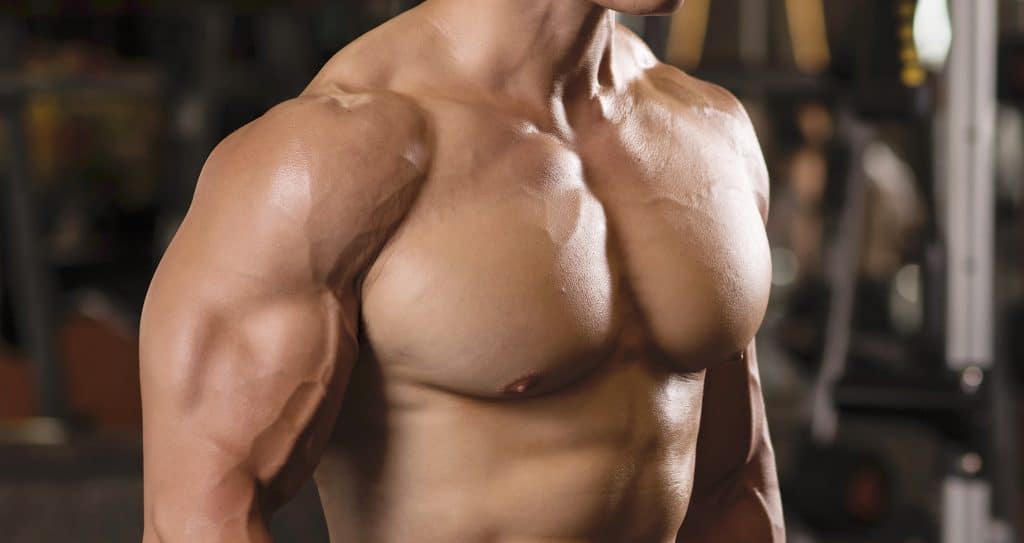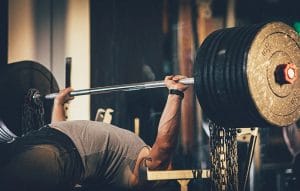The reverse grip dumbbell bench press gets your biceps involved.
Did you know that studies show men with a low waist-to-chest ratio were the most attractive feature (1)? So if you still need to prioritize chest exercises, now’s the time. Incorporating exercises like pushups, cable crossovers, and various press variations into your routine can contribute to muscle growth for that optimal waist-to-chest ratio. But changing the grip on chest exercises to a reverse grip – dumbbell press and barbell bench press – can lead to exceptional chest growth.
A press is a weightlifting exercise where you lie on a bench and push weight from your chest to the height of your arms when extended. Athletes consider the regular bench press using barbells as the standard of this routine. However, you can do a press with dumbbells and get many benefits.
When pressing a dumbbell, you can use a neutral, pronated, or underhand grip. However, the underhand or reverse grip offers a unique muscle stimulus. In this post, we look at how to use this grip properly, the benefits of doing a reverse grip dumbbell press, alternatives, and more.
Techniques and Muscles Worked
The reverse grip dumbbell press primarily targets your pecs, especially your upper pecs. This exercise engages your triceps, abs, biceps, forearms, and front delts. When completing this movement, you’ll feel it in your chest, arms, and shoulders.
You can do the reverse grip dumbbell press with an incline, decline, or flat bench. Using an incline bench increases the activation of your upper chest due to the angle. Below is a step-by-step guide on how to do this routine in proper form.
- Grab a set of dumbbells and then sit at the end of your incline, flat or decline bench. The ends of your dumbbells should be on your knees.
- Lay back on the bench slowly while pushing the dumbbell straight over your chest. Brace your core, arch your back, and push your feet into the floor.
- Next, twist the dumbbells until your palms face your shoulders. This is your starting position.
- Lower the dumbbells slowly until the handles reach your chest height, ensuring your palms stay in line.
- Pause when you reach chest height, and then return the dumbbells to starting position by extending your elbows to complete the rep.
Note: The reverse grip is more mechanical and hard to hold than other grips. Reducing your weight or using straps can help you avoid a slip and have a better grip.
Benefits
The reverse grip dumbbell press requires lots of discipline and patience to perform. However, the benefits make this exercise well worth your time. Below are some important reasons for using a reverse grip on dumbbell press.
Chest Muscle Hypertrophy
This exercise is necessary for lifters who want to add mass to their upper chest. It can generate massive muscle hypertrophy in those muscles due to the grip. The horizontal pressing movement, in particular, is a great way to build muscles in your upper body.
Bigger Biceps
Normally a press targets primarily your triceps, but using a reverse grip to do dumbbell press activates the biceps due to the position of your palms (2). The dumbbells allow for a greater range of motion and more natural movement.
Less Strain on Shoulders
Doing a reverse grip dumbbell press places less stimulus on your shoulder muscles than other bench press variations.
Change in Stimulus
The reverse grip dumbbell press offers a different stimulus to your muscles when pressing. The change in grip targets your chest muscles from a different angle, rounding out the muscular development in your pecs.
Add Variety and Break Plateaus
Many chest exercises use dumbbells or barbells with a pronated or neutral grip. This causes a similar movement pattern, leading to a plateau where your body adapts to the training mechanism. The reverse grip dumbbell press shocks your body. This study shows that varying your routine can help you avoid or break out of a plateau (3).
Improved Coordination and Balance
Doing a reverse grip dumbbell press will test your coordination. Depending on the weight, you must brace your core and use those muscles to keep your body stable. This exercise also strengthens your core, which leads to better posture and balance.
Better Grip and Forearm Strength
Holding the dumbbell using the reverse grip challenges your wrist mobility. You can start with a wrist strap to make things easier. Over time, your strength will increase, and you can avoid straps.
Reverse Grip Dumbell Press Alternatives
Are you ready to include this new way of holding dumbbells into your pressing regimen? Other reverse grip alternatives can make your training even more fun.
Reverse Grip Bench Press
The barbell bench press is a great way to build your chest muscles. Using a reverse grip increases upper chest and bicep activation. The reverse grip bench press uses barbells as the resistance, which allows you to use a heavier load.
Reverse Grip Machine Chest Press
The reverse grip machine chest press is a machine exercise that also focuses on your chest muscles. While using a machine doesn’t offer as many strength benefits as free weights, it’s great for muscle growth and isolating your chest muscles better. Plus, it’s safer.
Banded Chest Press
The banded chest press is a great way to build your chest muscles on the go or in your home gym. Resistance bands are similar to cables since they can keep constant tension on your muscles.
FAQs
What muscles do the reverse grip press work?
The reverse grip press builds your pecs, delts, biceps, triceps, and core muscles. For a more detailed breakdown, check the above guide.
Is the underhand dumbbell press good?
The underhand dumbbell press is another name for the reverse grip dumbbell press. This exercise is good for your chest muscles and biceps. We show you how it works in the guide above.
Which grip is best for dumbbell press?
The pronated, supinated, and neutral grip offer benefits depending on which muscles you want to focus on. The neutral grip activates the triceps more, while the supinated grip recruits the biceps better.
Follow us on Instagram, Facebook, and Twitter for more exercise guides!
References
- Brierley, M. E., Brooks, K. R., Mond, J., Stevenson, R. J., & Stephen, I. D. (2016). The Body and the Beautiful: Health, Attractiveness and Body Composition in Men’s and Women’s Bodies. PloS one, 11(6), e0156722. https://doi.org/10.1371/journal.pone.0156722
- Lehman G. J. (2005). The influence of grip width and forearm pronation/supination on upper-body myoelectric activity during the flat bench press. Journal of strength and conditioning research, 19(3), 587–591. https://doi.org/10.1519/R-15024.1
- Krzysztofik, M., Wilk, M., Wojdała, G., & Gołaś, A. (2019). Maximizing Muscle Hypertrophy: A Systematic Review of Advanced Resistance Training Techniques and Methods. International journal of environmental research and public health, 16(24), 4897. https://doi.org/10.3390/ijerph16244897









